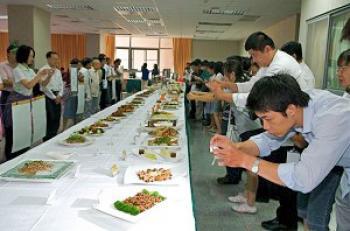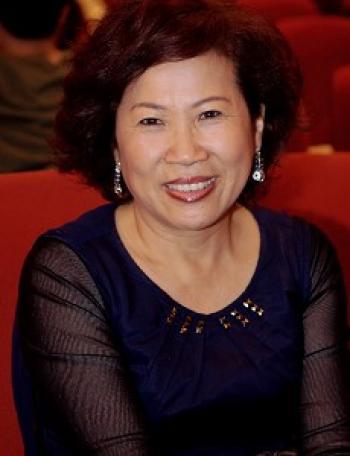The two-day Asia-Pacific preliminary round of the International Chinese Culinary Competition, sponsored by the New Tang Dynasty Television (NTDTV), concluded with astounding success on September 21, 2008 at Kaohsiung Hospitality College.
The Competition invited five world famous gourmets of Chinese culinary, who acted as judges for the five events of Guangdong Cuisine, Sichuan Cuisine, Huaiyang Cuisine, Shangdong Cuisine, and Northeastern Cuisine. “In general, the Competition is of a high level, with many prominent participants,” said Qu Yunqiang, head judge from New York. “It shows that the Competition has received a lot of attention and approval from the culinary community.”
Talking to reporters, Mr. Qu said, “The International Chinese Culinary Competition is aimed at restoring authentic Chinese gourmet culture. The look, the flavor, and the taste are of great importance in Chinese cuisine, with the taste most stressed.”
The participants in the Competition have shown great cutting, preparation and cooking skills, but were obviously lacking in flavorings. This is because they did not have a deep understanding and knowledge of the origins, cultures, peculiarities, and techniques of the respective cuisines, so that the supposed features of the food they prepared were somewhat lost, which is most unfortunate. In the modern world, people are confused about what the major authentic Chinese cuisines are, such as Huaiyang Cuisine, Shangdong Cuisine, and Northeastern Cuisine. The teachings of some of these cuisines have even been lost.
In fact, authentic Chinese cuisines are scientific and healthy gourmets. They are dynamic innovations, with a cultural foundation and local features.
Mr. Qu explained, “Take Sichuan Cuisine for example. Because of the local weather and culture, a spicy taste is specially treated, with layers of the taste. The Mapo Tofu prepared by some chefs was too sweet, because they didn’t know the tradition of ‘throw in some salt if you want it sweet.’ Thus the flavor didn’t have enough base flavors. The base flavor is the mother of all flavors. The six base flavors of Sichuan Cuisine are hot, spicy, sweet, salty, sour, and bitter. ”
From these six base flavors grow variations. In the preparation of Sichuan Cuisine, the appropriate application of flavors, tastes, amounts, and mixtures, coupled with a careful choice of ingredients, combination and cooking will produce various gourmet dishes with enticing, flavors, tastes, and appearances.
The Competition invited five world famous gourmets of Chinese culinary, who acted as judges for the five events of Guangdong Cuisine, Sichuan Cuisine, Huaiyang Cuisine, Shangdong Cuisine, and Northeastern Cuisine. “In general, the Competition is of a high level, with many prominent participants,” said Qu Yunqiang, head judge from New York. “It shows that the Competition has received a lot of attention and approval from the culinary community.”
Talking to reporters, Mr. Qu said, “The International Chinese Culinary Competition is aimed at restoring authentic Chinese gourmet culture. The look, the flavor, and the taste are of great importance in Chinese cuisine, with the taste most stressed.”
The participants in the Competition have shown great cutting, preparation and cooking skills, but were obviously lacking in flavorings. This is because they did not have a deep understanding and knowledge of the origins, cultures, peculiarities, and techniques of the respective cuisines, so that the supposed features of the food they prepared were somewhat lost, which is most unfortunate. In the modern world, people are confused about what the major authentic Chinese cuisines are, such as Huaiyang Cuisine, Shangdong Cuisine, and Northeastern Cuisine. The teachings of some of these cuisines have even been lost.
In fact, authentic Chinese cuisines are scientific and healthy gourmets. They are dynamic innovations, with a cultural foundation and local features.
Mr. Qu explained, “Take Sichuan Cuisine for example. Because of the local weather and culture, a spicy taste is specially treated, with layers of the taste. The Mapo Tofu prepared by some chefs was too sweet, because they didn’t know the tradition of ‘throw in some salt if you want it sweet.’ Thus the flavor didn’t have enough base flavors. The base flavor is the mother of all flavors. The six base flavors of Sichuan Cuisine are hot, spicy, sweet, salty, sour, and bitter. ”
From these six base flavors grow variations. In the preparation of Sichuan Cuisine, the appropriate application of flavors, tastes, amounts, and mixtures, coupled with a careful choice of ingredients, combination and cooking will produce various gourmet dishes with enticing, flavors, tastes, and appearances.





